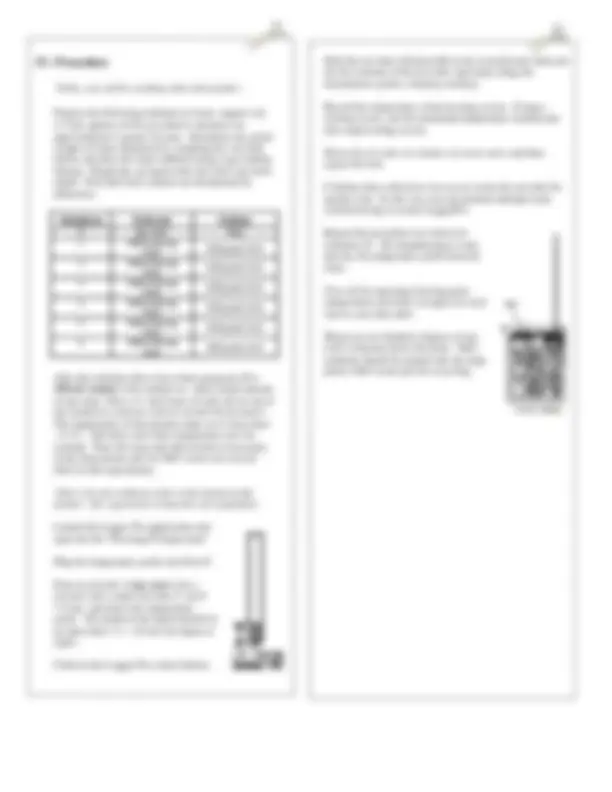





Study with the several resources on Docsity

Earn points by helping other students or get them with a premium plan


Prepare for your exams
Study with the several resources on Docsity

Earn points to download
Earn points by helping other students or get them with a premium plan
Community
Ask the community for help and clear up your study doubts
Discover the best universities in your country according to Docsity users
Free resources
Download our free guides on studying techniques, anxiety management strategies, and thesis advice from Docsity tutors
In this case the ideal van't Hoff factor equals two. On the other hand, calcium chloride,. CaCl2, used on city streets to lower the freezing point of water and ...
Typology: Study notes
1 / 5

This page cannot be seen from the preview
Don't miss anything!




Minneapolis Community and Technical College C1152 v.12.
The physical properties of solutions that depend on the number of dissolved solute particles and not their specific type are known as colligative properties. These include freezing point depression, osmotic pressure, and boiling point elevation.
Freezing point depression occurs when a solute is added to a solvent producing a solution having lower freezing point temperature than the pure solvent. The freezing point temperature decreases by an amount T determined by the following formula:
where
Kf is the freezing point depression constant of the solvent (units: oC/molal). For water, K f = 1.86 oC/molal. i” is the van’t Hoff factor for the dissolved solute (unitless) m is the molality of the solution in moles of solute particles per kilogram of solvent (units: moles/kg).
One way to understand the freezing point depression effect is to consider the solute particles as interfering or standing between the solvent particles. With greater space between solvent particles, intermolecular forces are weaker. Consequently, lower temperatures are required to make it possible for solvent particles to approach each other and form the solid.
Also important is the role of the van’t Hoff factor “i”. For example, a 2.0 molal solution of NaCl has a particle concentration equal to 4.0 molal since each formula unit splits into two pieces (Na+^ and Cl-^ ) creating twice the number of free floating particles (ions). In this case the ideal van’t Hoff factor, iideal = 2. CaCl 2 is used on city streets to lower the freezing point of water and thus melt away the ice. CaCl 2 breaks up ideally into three ions: (Ca2+^ , Cl-^ , Cl-^ ) and in this case iideal = 3. Lastly, Na3PO (^) 4, used in commercial cleaning applications breaks up into 4 ions (Na+^ , Na+^ , Na+^ , PO 4 3-^ ) and it’s ideal van’t Hoff factor is 4. Note that polyatomic ions do not break up into their constituent elements.
Ion pairing reduces the number of particles in solution and thus the van’t Hoff factor. In reality cations and anions momentarily pair up in solution since after all they are oppositely charged and do attract each other. When they do, a single particle is created from what had been two. Thus, slightly fewer particles are actually present and the experimental van’t Hoff factor is less than the ideal value.
It will always be true that iexp < iideal since it is impossible to make more particles than what is predicted ideally.
One interesting application of freezing point depression is the making of homemade ice cream. The ice cream maker (figure at right) consists of two containers: the inner steel container that holds the ice cream mixture and the outer container that holds an ice/water/salt mixture. The addition of salt to the ice/water depresses its freezing point producing temperatures much lower than 0oC. This cools the inner container where the ice cream mix freezes to the inner walls as they are very cold. Crank powered scrapers remove the newly frozen ice cream from the inner surfaces continuously until all of the ice cream has frozen.
Observing freezing point behavior
You can observe the freezing point behavior of solvents and solutions by immersing small amounts of them in a very cold ice bath whilst monitoring the temperature with a temperature probe. Ideally, the temperature behavior you observe would resemble the figure at right. The initial downward slope represents the cooling of the originally warm solution. The discontinuity or bend identifies the point where freezing first occurs and Tf.
Super cooling is the process by which a liquid or solution is cooled below its freezing point temperature. Incredible as it might seem, the liquid continues to exist as a liquid even though it ought to be a solid. This unusual situation is quite unstable and needs only a slight disturbance (e.g. a bump or seed crystal) to initiate the crystal formation whereby it converts entirely to a solid.
Super cooled water droplets presented problems for early aircraft. Before jet powered airplanes made it possible to fly over clouds, propeller driven aircraft were forced to fly through clouds. In doing so, super cooled water droplets within the cloud would instantly turn to ice on the airplane’s wings and propellers. If enough ice accumulated on the airplane it would become too heavy to fly. To remedy this situation, wing surfaces prone to “icing” would have special equipment designed to either melt or break away accumulating ice.
Experimentally, you’ll likely see super cooling effects as a drop in temperature followed by a fast return to the actual freezing point of the liquid. In the figure at right, super cooling is identified as the dip in the graph. When the solution does abruptly begin to freeze, the temperature returns to a point approximately equal to the initial freezing point temperature for a short time. ( This approximation becomes less accurate as the amount of super cooling increases.) Note that the freezing point temperature is NOT determined at the bottom of the dip but rather the temperature associated with the sudden rise labeled in the figure as Tf.
Thus, freezing point temperatures (Tf ) can be determined in non-super cooling trials at the bend in the graph or as the maximum temperature reached in super cooling trials. If possible, you should attempt to replicate the same behavior for all of your trials (i.e. all super cooling). Because the stirring technique has a significant effect on the cooling curve, your lab instructor will demonstrate the best technique at the beginning of lab.
Temperature Measurements and T calculations
T in equation #1 above refers to the difference between the pure solvent’s freezing point temperature and any of the 6 other solutions you construct. Mathematically, we determine this difference six times as follows:
We cannot assume 0oC as the freezing point of pure water (a.k.a. solvent) because we won’t be calibrating the temperature probe. Rather we’ll assume the error in all of our temperature measurements is the same. Consequently, these errors subtract to zero when
we calculate T. This can be mathematically understood as follows:
T = (Tsolvent + error ) – (T solution + error ) = Tsolvent + error – T solution – error = Tsolvent – T solution
Determination of the van’t Hoft factor
The goal of today’s experiment is to experimentally determine a value of the van’t Hoff factor for CaCl 2. We’ll do this by recognizing
that a plot of T on the Y axis versus the product ( K f m) on the X axis should produce a straight line. Comparing equation #1 to the familiar slope intercept form we have:
Clearly, the slope of the graph (m) is the value for the van’t Hoff factor “i”.
You’ll analyze your data by creating a T vs (Kf m) scatter plot where one point will appear for each of the six solutions and the pure water sample. The latter appears on the graph as the point (0,0).
A trend line analysis of the scatter plot delivers a value for the slope of the line and the CaCl 2 van’t Hoff factor.
Today, you will be working with a lab partner.
Prepare the following solutions in clean, capped vial. A 5 mL pipette will be provided to measure out approximately 5 grams of water. Determine the actual weight of water dispensed by weighing the vial both before and after the water addition using a top loading balance. Weigh the vial again after the CaCl 2 has been added. H (^) 2O and CaCl 2 masses are determined by difference.
After the solutions above have been prepared, fill a 250 mL beaker with crushed ice. Add a small amount of tap water. Pour a ¼ inch layer of rock salt on top of the crushed ice and stir with an alcohol thermometer. The temperature of this mixture must at or lower than –14 oC. Add more salt if this temperature can’t be reached. Pour off water and add ice/salt as necessary in the large plastic pail for NaCl waste (we recycle NaCl in this experiment).
*Don’t let salt sediment settle at the bottom of the beaker! Stir vigorously to keep the salt suspended.
Launch the Logger Pro application and open the file “Freezing Pt Depression”
Plug the temperature probe into Port #
Pour several mL of tap water (a.k.a. solvent) into a small test tube (1 cm X 7.5 cm) and insert the temperature probe. The depth of the liquid should be no more than 1.5 – 2.0 cm (see figure at right).
Click on the Logger Pro collect button.
Hold the test tube (Solution #0) in the ice/salt/water bath and stir the contents of the test tube vigorously using the thermometer probe (vibratory motion).
Record the temperature when freezing occurs. If super- cooling occurs, use the maximum temperature reached just after supercooling occurs.
Warm the test tube in a beaker of warm water and then repeat the trial.
Continue data collection even as you warm the test tube for another trial. In this way you can perform multiple trials without having to restart LoggerPro.
Repeat this procedure two times for solutions #1 - #6 remembering to rinse and dry the temperature probe between trials.
You will be reporting freezing point temperatures and their averages for each trial in your data table.
When you are finished, dispose of any CaCl 2 solutions down the drain. NaCl solutions should be poured into the large plastic NaCl waste pail for recycling.
0 tap water None 1 5.00 grams tap water 0.50 gram CaCl^2 2 5.00 grams tap water 0.40 gram CaCl^2 3 5.00 grams tap water 0.30 gram CaCl^2 4 5.00 grams tap water 0.20 gram CaCl^2 5 5.00 grams tap water 0.10 gram CaCl^2 6 5.00 grams tap water 0.05 gram CaCl^2
Solvent Mass (g)
Solute Mass (g)
Solute moles
Concentratio n (molality) Kf^ x m^
T f Trial 1
T f Trial 2 Average T^ f^ T^ f
Solution 1
Solution 2
Solution 3
Solution 4
Solution 5
Solution 6